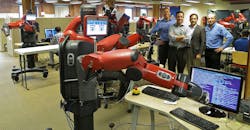We are still in the midst of Industry 4.0, where manufacturing has taken on the label of “smart” through the integration of the IoT, AI, cyber-physical systems, and Cloud and cognitive computing. The basic principle behind the fourth industrial revolution is that by chaining machines, intelligent devices, and systems, manufacturers are creating smart networks throughout the value chain (from materials to production) that can control each other.
With that being said, it’s amazing that technological advancements continue to grow at an incredible speed—so much so that Industry 5.0 can already be seen on the horizon, which according to some tech visionaries, will bring an increased human touch back to manufacturing. Therefore, where Industry 4.0 put smart technology at the forefront of manufacturing, 5.0 will be increased collaboration between humans and smart systems. Marrying the two will merge the high-speed accuracy of industrial automation with the cognitive, critical thinking skills of humans.
According to Universal Robots Chief Technology Officer Esben H. Østergaard, Industry 5.0 is necessary due to consumers high-demand of individualization in the products they buy, meaning they prefer a degree of “hands-on” personalization and customization with their products. To back up his statement, Esben cites an article from Bloomberg detailing auto manufacturer Mercedes’ decision to give more space to humans in the production factories, noting that customization is an important factor with modern consumers.
More and more manufacturers are increasing the human component not only for the customization, but also for increased efficiency on the production line. One example is Toronto’s Paradigm Electronics, which manufactures high-end loudspeakers. The company uses Universal Robots’ UR10 robotic arm to polish the speaker cabs to a high-luster sheen, but it takes considerable time to do so. By adding a human counterpart, however, it increased its production efficiency by 50%.
This isn’t to say robots will eventually be phased out of the production cycle. On the contrary: Industry 5.0 will enhance both machine and human roles in the manufacturing industry, leaving the monotonous, repetitive tasks to the mechanical and opening up the creative side to the biological. This will allow staff to take on more responsibility and increased supervision of systems to elevate the quality of production across the board.
The idea of collaboration between humans and robots on the assembly line is not a vision of the distant future. In fact, consulting firm Accenture recently released an outlook from a survey they conducted with 512 manufacturing execs from all over the globe, revealing that 85% of them envision a collaborative production line between humans and robots in their plants by 2020. It’s quite the impressive outlook, considering that target date is just three years away.
That projection may be alarming to some manufacturers who have only begun to adopt Industry 4.0 standards, but it doesn’t need to be. Human/robot collaboration is already taking place on the production line, as mentioned earlier. It’s a natural evolution that will take place within the smart manufacturing industry, and robotics producers have already developed collaborative robots that are safe to use around human workers to prevent injuries in the workplace.
Although Industry 4.0 is still the foremost revolution on most manufacturers’ minds, it’s also important to keep an eye on the future. Technology is constantly advancing, and production must evolve with it to remain competitive. With the increase in demand for quality hands-on custom-made products, manufacturers will undoubtedly benefit from what Industry 5.0 has to offer, and perhaps it will reduce the inherent fear most production workers have concerning being replaced by automation. New skills are necessary, but the collaborative workplace will be beneficial for all in the long term. All we need to do is keep an open mind.
Industry is being “versioned” way too willy-nilly. We need versioning control! Without a better way of describing innovation in industry, we are doomed to see more “upgrading” of industry, since it is an attention-grabber. So, let me now coin the term “Industry 6.0,” where we never interface with any machine, person, or drafting table/setup. Instead, it’s all done in an app. We take a picture of a rough sketch and click “make it.”
About the Author
Cabe Atwell
Engineer, Machinist, Maker, Writer. A graduate Electrical Engineer actively plying his expertise in the industry and at his company, Gunhead. When not designing/building, he creates a steady torrent of projects and content in the media world. Many of his projects and articles are online at element14 & SolidSmack, industry-focused work at EETimes & EDN, and offbeat articles at Make Magazine. Currently, you can find him hosting webinars and contributing to Penton’s Electronic Design and Machine Design.




